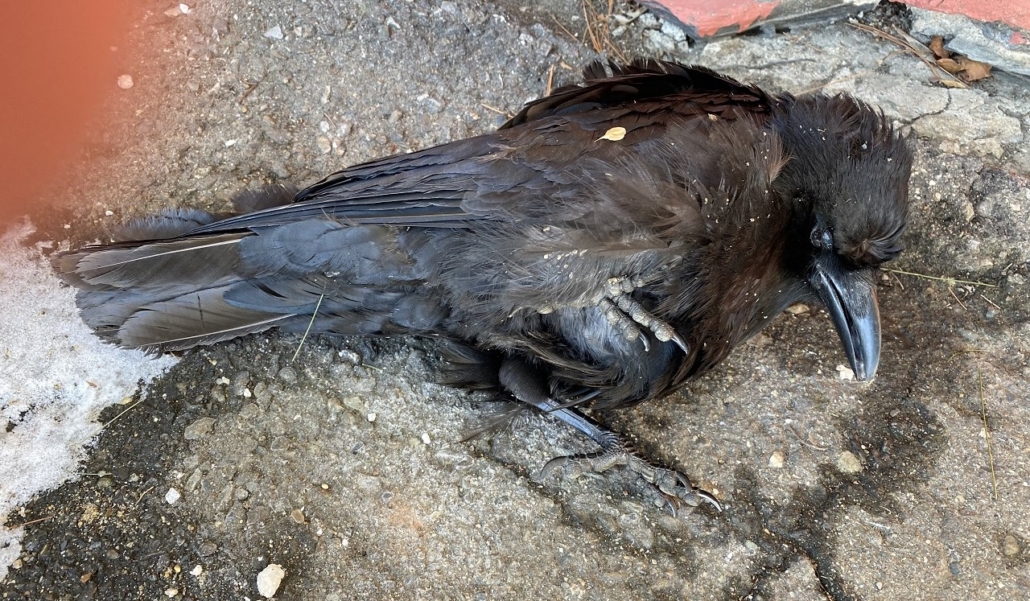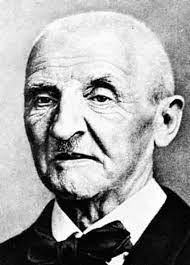
A crow found dead near the stairs to our house. (photo by Roland Hallee)
A black cat crossing your path; walking under a ladder; breaking a mirror: take your pick of long-standing superstitions. Most of us have some kind of superstition, although some don’t want to admit it.
But I’m getting ahead of myself.
My wife leaves for work before I do, and one morning last week, she informed me there was a dead crow at the bottom of the stairs to the porch at our house. So, I went out to investigate. Sure enough, there he was, stiff as a board. I didn’t know whether it was frozen, or rigor mortis had already set in.
Now, all kinds of thoughts went through my head. There is another superstition about robins appearing at your window. That one goes like this: Robins are often seen as a sign of visits from our deceased family members or loved ones in the spiritual world, and many people take a visit from one as a sign that one is on its way. In addition to representing a fresh start in life, the Robin is seen by many as a lucky charm.
So, if a robin is some form of good fortune, what can a crow mean, especially a dead one.
Few birds are more misunderstood than crows. They are commonly associated with death and misfortune, but the dead crow meaning is thought to suggest the opposite – potentially bringing good news and positive change to those who see it. Though different people and belief systems hold many varying ideas, it is the crow’s connection to transformation and change – of a good or bad kind – which seems to remain a common theme.
So, to the computer I went to see what I could learn about birds in our lives. This is what I came up with.
Many of us have seen a dead crow in our lives, but what does the symbolism of this creature say about you? Dead crows are often associated with death and mourning. If you come across one during your day, it might be time to reflect on what is important to you. Dead crows also symbolize loneliness and despair.
Crows are commonly associated with death and misfortune – a black-colored bird that portends doom. However, this is the crow symbolism when alive. The dead crow meaning is thought to suggest the opposite, potentially bringing good news and positive change to those who see it.
Now, I am an optimistic person, always seeing the bright side of things. So, seeing that dead crow more than likely means something positive is about to happen. I’m not sure what that might be.
So, what remains to be seen is what is going to happen, and how long it takes. I’m sure there is an expiration date on superstitious activity.
Birds are geniuses and bird symbolism is a vast topic but it seems to be agreed that the meaning behind seeing a dead bird depends on what type of bird it is. We’ve already mentioned the fact that a crow’s death might suggest positive outcomes for those who see them, yet there is also a belief that dead blackbirds, including crows, point to an unresolved tension deep inside someone. This is because the color black represents that which we cannot see.
A white bird depicting purity, peace, and goodness – such as a dove – is tragic and ominous in death. They might forbode the loss of something special, or an approaching conflict, depending on the happenings in an individual’s life. If the bird has positive associations when alive, it makes sense that its death would have a negative meaning.
Since songbirds represent communication, their death should encourage us to ask ourselves if we’re hiding something: perhaps we’re not speaking up, or we’ve lost touch with someone in our lives.
Another factor that changes the meaning of seeing a dead bird is the location. If a dead bird falls on your doorstep or in your garden, you must expect that change is coming soon, whether you want it or not. It’s best to change your habits and not resist this change.
If the bird hits your window, this means you are confronting an obstacle that must be overcome or removed. Lastly, if it comes inside your house, you need to look inwardly since the change going on is inside yourself. The consistent theme is one of transformation and change, whether that’s in a positive or negative way. The important thing is to not resist the change that is happening but find a way to adapt.
Crows are believed to guide us towards change – to prepare us for a transition in our lives. Their adaptability is an example to us, showing that we too need to change to survive. When one appears before you, it is encouragement not to resist that change that is coming and inevitable. Since dying is perhaps the biggest change of all, their role in the process of death is unsurprising.
The crow is a bird that has been deeply entrenched in the mythology of many different cultures and religions. It’s believed to be more than just an animal, but rather some kind of spiritual messenger or omen for change. In Greek Mythology it was considered sacred, while Native American tribes have viewed them as guardians and healers. The crow has also been revered in other parts of the world for its clever nature and intelligence.
In many cultures, the crow was seen as a messenger of death. Crows have often been found near battlefields and they were once believed to be the souls of warriors who had not yet crossed over from this life into the next.
As recently as World War II, people interpreted dead or wounded crows in their own way but it is generally accepted today that they are not considered an omen of death.
An occurrence in which one sees dead crows is typically not a sign that something bad will happen, but rather an omen of change. Dead crows are often seen as messengers, specifically heralding the coming of a new era or event in one’s life. Dead crows have been known to represent death and transformation.
Dead crows are also seen as messengers, specifically heralding the coming of a new era or event in one’s life. In some cultures, they also signify being free from bondage or restriction. Seeing dead crows can be interpreted as a sign of change on the horizon.
There is a Biblical meaning of dead birds. A bird’s ability to fly puts them closer to the heavens and elevates them above the human world, giving them a special role in religion. Some types of birds came to represent parts of the Christian soul and the Saints themselves. The white dove was particularly significant, representing the Holy Spirit and indicating a blessing from God.
On the other hand, dead birds were considered to show failure – a warning to prepare someone for the challenges ahead. They might also be a sign of a loved one passing away.
After reading all of this, I think I will take the high road, and say the bird prophesized a positive change. We were recently told we will become great-grandparents for the second time.
Did I mention that I am not superstitious?
Roland’s trivia question of the week?
Name the six NFL teams that have won only one Super Bowl.
Answer can be found here.
 by Peter Cates
by Peter Cates










 by John D. Koons
by John D. Koons




